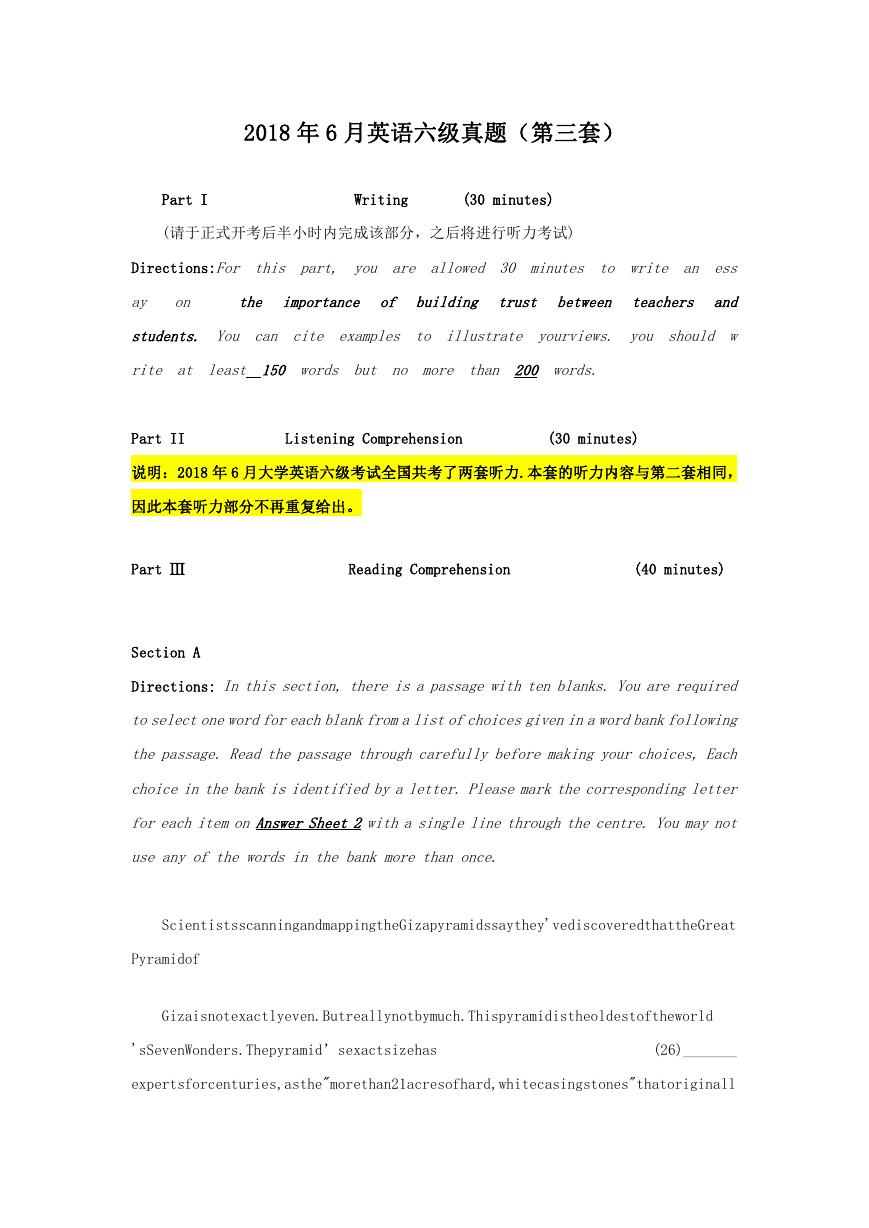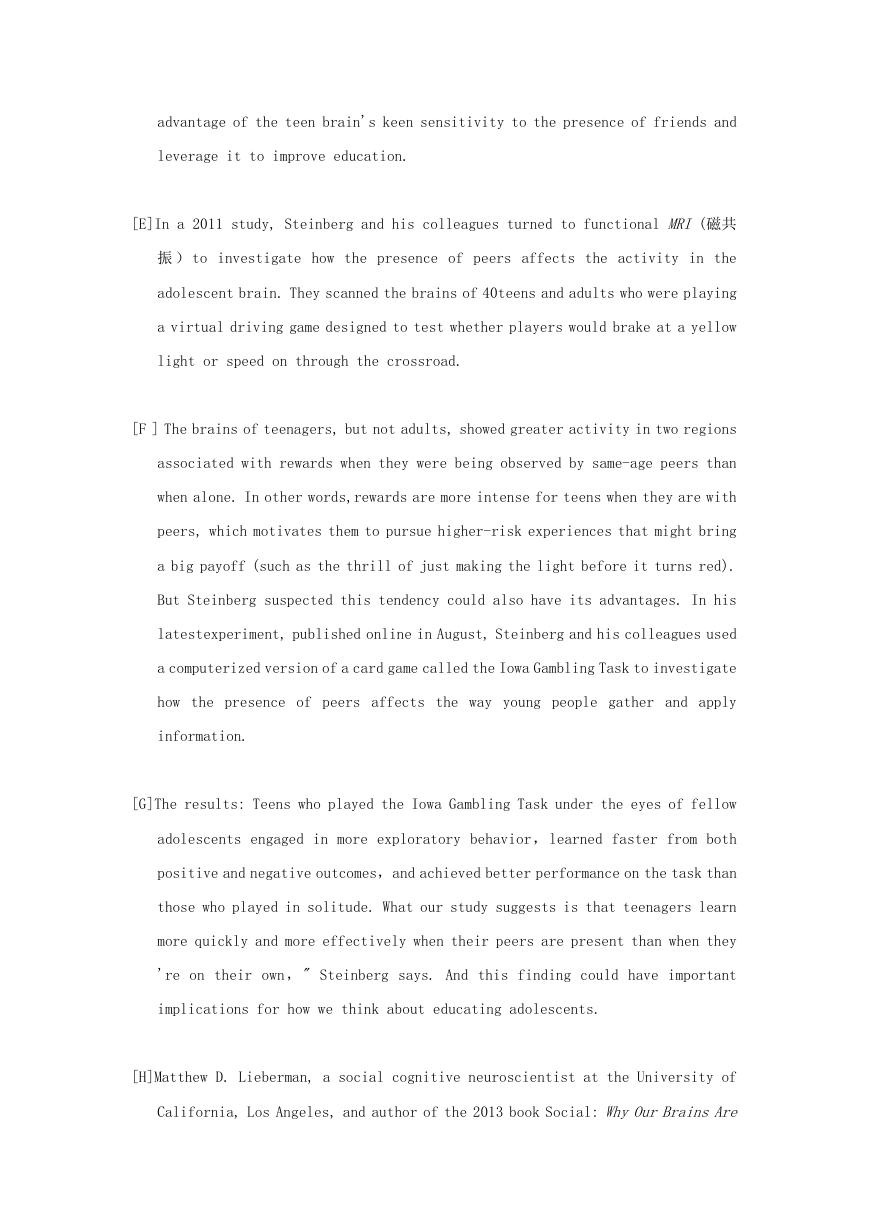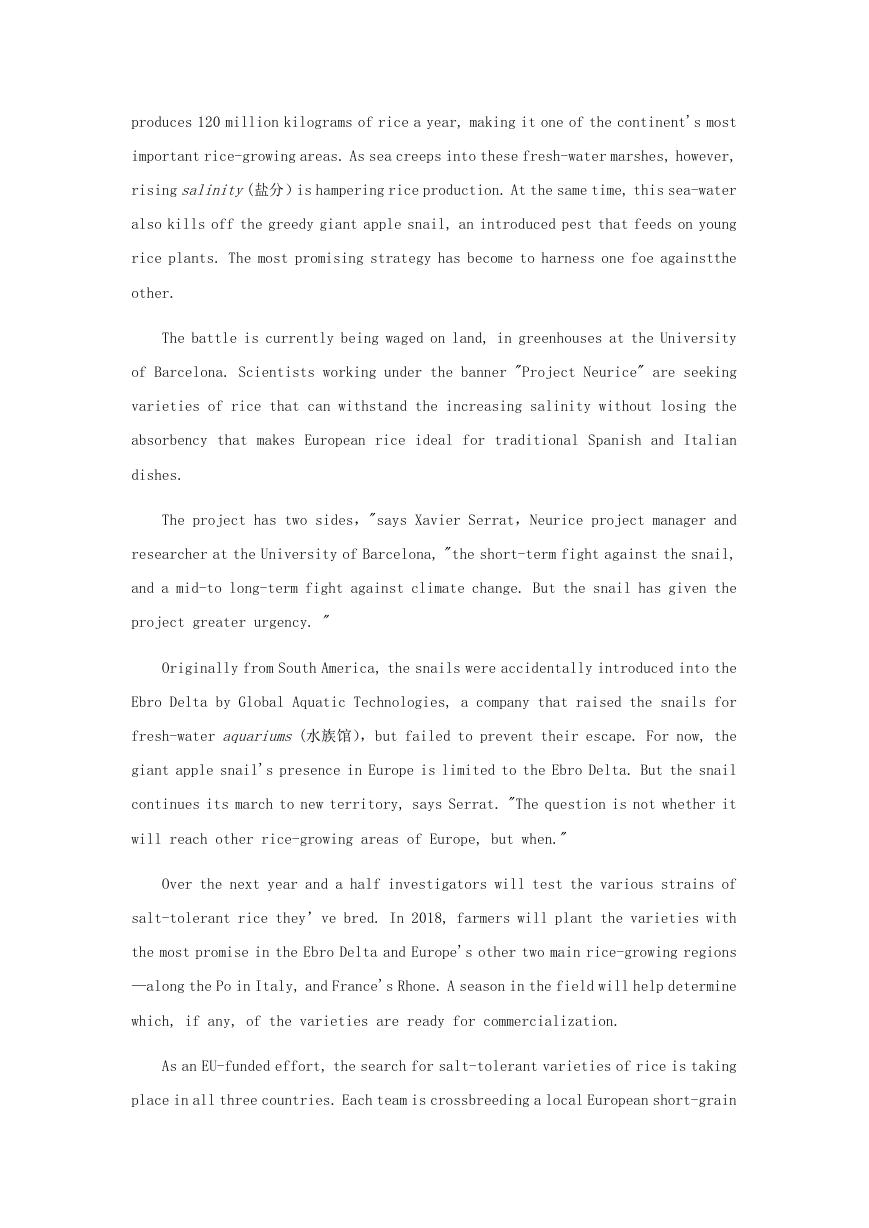2018 年 6 月英语六级真题(第三套)
Part I
Writing
(30 minutes)
(请于正式开考后半小时内完成该部分,之后将进行听力考试)
Directions:For this part, you are allowed 30 minutes to write an ess
ay on
the importance of building trust between teachers and
students. You can cite examples to illustrate yourviews. you should w
rite at least 150 words but no more than 200 words.
Part II
Listening Comprehension
(30 minutes)
说明:2018 年 6 月大学英语六级考试全国共考了两套听力.本套的听力内容与第二套相同,
因此本套听力部分不再重复给出。
Part Ⅲ
Reading Comprehension
(40 minutes)
Section A
Directions: In this section, there isa passagewithten blanks.Youarerequired
toselectonewordforeachblankfromalistofchoicesgiveninawordbankfollowing
the passage. Read the passage through carefully before making your choices, Each
choiceinthebankisidentifiedbyaletter.Pleasemarkthecorrespondingletter
foreachitemonAnswerSheet2withasinglelinethroughthecentre.Youmaynot
use any of the words in the bank more than once.
ScientistsscanningandmappingtheGizapyramidssaythey'vediscoveredthattheGreat
Pyramidof
Gizaisnotexactlyeven.Butreallynotbymuch.Thispyramidistheoldestoftheworld
'sSevenWonders.Thepyramid’sexactsizehas
(26)_______
expertsforcenturies,asthe"morethan21acresofhard,whitecasingstones"thatoriginall
�
ycovereditwere(27)_______
longago.Reportinginthemostrecentissueofthenewsletter"AERAGRAM",which
(28)_______ theworkoftheAncientEgyptResearchAssociates, engineer Glen Dash says
his
team
used
a
new
measuring
approach
that
involved
finding
any
surviving(29)_______ of the casing in order to determine where the original edge
was. They found the eastside of the pyramid to be a 30)_______ of 5.5 inches shorter
than the west side.
The question that most 31)_______ him, however, isn’t how the Egyptians who
designed and built the pyramid got it wrong 4,500 years ago, but how they got it
so dose to 32)_______ . "We can only speculate as how the Egyptians could have laid
out these lines with such(33)_______ using only the tools they had,"Dash writes.
He says his
34)_______ is that the Egyptians laid out their design on a grid, noting
that the great pyramid is oriented only (35)_______ away from the cardinal directions
(its north-south axis runs 3 minutes 54 seconds west of due north,while
its
east-west axis runs 3 minutes 51 seconds north of due east)—an amount that’s "tiny
but similar", archeologist Atlas Obscura points out.
注意:此部分试题请在答题卡 2 上作答。
A)chronicles
B) complete
C) established
D) fascinates
E) hypothesis
F) maximum
G) momentum
H) mysteriously
I) perfect
J)precision
K)puzzled
L)remnants
M)removed
N)revelations
O)slightly
Section B
Directions:Inthissection,youaregoingtoreadapassagewithtenstatements
attachedtoit.Eachstatementcontainsinformationgiveninoneoftheparagraphs.
Identify the paragraph from which the information is derived. You may choose a
paragraph more than once. Each paragraph is marked with a letter. Answer the
questions by marking the corresponding letter on Answer Sheet 2.
�
Peer Pressure Has a Positive Side
[A] Parents of teenagers often view their children's friends with something like
suspicion. They worry that the adolescent peer group has the power to push its
members into behavior that is foolish and even dangerous. Such wariness is well
founded: statistics show, for example, that a teenage driver with a same-age
passenger in the car is at higher risk of a fatal crash than an adolescent driving
alone or with an adult.
[B] In a 2005 study, psychologist Laurence Steinberg of Temple University and his
co-author, psychologist Margo Gardner, then at Temple, divided 306 people into
three age groups: young adolescents, with a mean age of 14; older adolescents,
with a mean age of 19; and adults, aged 24 and older. Subjects played a
computerized driving game in which the player must avoid crashing into a wall
that materializes, without warning, on the roadway. Steinberg and Gardner
randomly assigned some participants to play alone or with two same-age peers
looking on.
[C] Older adolescents scored about 50 percent higher on an index of risky driving
when their peers were in the room—and the driving of early adolescents was fully
twice as reckless when other young teens were around. In contrast, adults behaved
in similar ways regardless of whether they were on their own or observed by others.
"The presence of peers makes adolescents and youth, but not adults, more likely
to take risks," Steinberg and Gardner concluded.
[D]Yet in the years following the publication of this study, Steinberg began to
believe that this interpretation did not capture the whole picture. As he and
other researchers examined the question of why teens were more apt to take risks
in the company of other teenagers, they came to suspect that a crowd 's influence
need not always be negative. Now some experts are proposing that we should take
�
advantage of the teen brain's keen sensitivity to the presence of friends and
leverage it to improve education.
[E]In a 2011 study, Steinberg and his colleagues turned to functional MRI (磁共
振 ) to investigate how the presence of peers affects the activity in the
adolescent brain. They scanned the brains of 40teens and adults who were playing
a virtual driving game designed to test whether players would brake at a yellow
light or speed on through the crossroad.
[F ] The brains of teenagers, but not adults, showed greater activity in two regions
associated with rewards when they were being observed by same-age peers than
when alone. In other words,rewards are more intense for teens when they are with
peers, which motivates them to pursue higher-risk experiences that might bring
a big payoff (such as the thrill of just making the light before it turns red).
But Steinberg suspected this tendency could also have its advantages. In his
latestexperiment, published online in August, Steinberg and his colleagues used
a computerized version of a card game called the Iowa Gambling Task to investigate
how the presence of peers affects the way young people gather and apply
information.
[G]The results: Teens who played the Iowa Gambling Task under the eyes of fellow
adolescents engaged in more exploratory behavior,learned faster from both
positive and negative outcomes,and achieved better performance on the task than
those who played in solitude. What our study suggests is that teenagers learn
more quickly and more effectively when their peers are present than when they
're on their own, " Steinberg says. And this finding could have important
implications for how we think about educating adolescents.
[H]Matthew D. Lieberman, a social cognitive neuroscientist at the University of
California, Los Angeles, and author of the 2013 book Social: WhyOurBrainsAre
�
WiredtoConnect,suspects that the human brain is especially skillful at learning
socially significant information. He points to a classic 2004 study in which
psychologists at Dartmouth College and Harvard University used functional MRI
to track brain activity in 17 young men as they listened to descriptions of people
while concentrating on either socially relevant cues ( for example,trying to
form an impression of a person based on the description) or more socially neutral
information (such as noting the order of details in the description). The
descriptions were the same in each condition, but people could better remember
these statements when given a social motivation.
[I]The study also found that when subjects thought about and later recalled
descriptions in terms of theirinformational content, regions associated with
factual memory, such as the medial temporal lobe, became active. But thinking
about or remembering descriptions in terms of their social meaning activated
the dorsomedial prefrontal cortex—part of the brain's social network—even as
traditionalmemory regions registered low levels of activity. More recently, as
he reported in a 2012 review, Lieberman has discovered that this region may be
part of a distinct network involved in socially motivated learning and memory.
Such findings, he says, suggest that "this network can be called on to process
and store the kind of information taught in school—potentially giving students
access to a range of untapped mental powers".
[J]If humans are generally geared to recall details about one another, this pattern
is probably even more powerful among teenagers who are very attentive to social
details: who is in, who is out, who likes whom, who is mad at whom. Their desire
for social drama is not—or not only—a way of distracting themselves from their
schoolwork or of driving adults crazy. It is actually a neurological (神经的)
sensitivity, initiated by hormonal changes. Evolutionarily speaking, people in
this age group are at a stage in which they can prepare to find a mate and start
their own family while separating from parents and striking out on their own.
�
To do this successfully, their brain prompts them to think and even obsess about
others.
[K]Yet our schools focus primarily on students as individual entities. What would
happen if educators instead took advantage of the fact that teens are powerfully
compelled to think in social terms? In Social,Lieberman lays out a number of
ways to do so. History and English could be presented through the lens of the
psychological drives of the people involved. One could therefore present
Napoleon in terms of his desire to impress or Churchill in terms of his lonely
gloom. Less inherently interpersonal subjects, such as math, could acquire a
social aspect through team problem solving and peer tutoring. Research shows
that when we absorb information in order to teach it to someone else, we learn
it more accurately and deeply, perhaps in part because we are engaging our social
cognition.
[L]And although anxious parents may not welcome the notion, educators could turn
adolescent recklessness to academic ends."Risk taking in an educational context
is a vital skill that-enables progress and creativity," wrote Sarah-Jayne
Blakemore, a cognitive neuroscientist at University College London, in a review
published last year. Yet, she noted, many young people are especially unwilling
to take risks at school—afraid that one low test score or poor grade could cost
them a spot at a selective university. We should assure such students that risk,
and even peer pressure, can be a good thing—as long as it happens in the classroom
and not in the car.
注意:此部分试题请在答题卡 2 上作答。
36.Itisthoughtprobablethatthehumanbrainisparticularlygoodatpickingupsociallyimp
�
ortantinformation.
37.Itcanbeconcludedfromexperimentsthatthepresenceofpeersincreasesrisk-takingbya
dolescentsandyouth.
38.Studentsshouldbetoldthatrisk-takingintheclassroomcanbesomethingpositive.
39.Theurgeoffindingamateandgettingmarriedaccountsforadolescents'greaterattentio
ntosocialinteractions.
40.AccordingtoSteinberg,thepresenceofpeersincreasesthespeedandeffectivenessofte
enagers’learning.
41.Teenagers'parentsareoftenconcernedaboutnegativepeerinfluence.
42.Activatingthebrain'ssocialnetworkinvolvedinsociallymotivatedlearningandmemor
ymayallowstudentstotapunusedmentalpowers.
43.Thepresenceofpeersintensifiesthefeelingofrewardsinteens'brains.
44.Whenweabsorbinformationforthepurposeofimpartingittoothers,wedosowithgreatera
ccuracyanddepth.
45.Someexpertsaresuggestingthatweturnpeerinfluencetogooduseineducation.
Section C
Directions: There are2passagesinthissection.Eachpassageis followedby
some questions or unfinished statements. For each of them there are four choices
marked A), B), C) and D). You should decide on the best choice and mark the
corresponding letter on Answer Sheet 2with a single line through the centre.
Passage One
Questions 46 to 50 are based on the following passage.
The Ebro Delta, in Spain, famous as a battleground during the Spanish Civil War,
is now the setting for a different contest, one that is pitting rice farmers against
two enemies:the rice-eating giant apple snail, and rising sea levels. What happens
here will have a bearing on the future of European rice production and the overall
health of southern European wetlands.
Located on the Mediterranean just two hours south of Barcelona, the Ebro Delta
�
produces 120 million kilograms of rice a year, making it one of the continent's most
important rice-growing areas. As sea creeps into these fresh-water marshes, however,
rising salinity(盐分)is hampering rice production. At the same time, this sea-water
also kills off the greedy giant apple snail, an introduced pest that feeds on young
rice plants. The most promising strategy has become to harness one foe againstthe
other.
The battle is currently being waged on land, in greenhouses at the University
of Barcelona. Scientists working under the banner "Project Neurice" are seeking
varieties of rice that can withstand the increasing salinity without losing the
absorbency that makes European rice ideal for traditional Spanish and Italian
dishes.
The project has two sides,"says Xavier Serrat,Neurice project manager and
researcher at the University of Barcelona, "the short-term fight against the snail,
and a mid-to long-term fight against climate change. But the snail has given the
project greater urgency. "
Originally from South America, the snails were accidentally introduced into the
Ebro Delta by Global Aquatic Technologies, a company that raised the snails for
fresh-water aquariums (水族馆),but failed to prevent their escape. For now, the
giant apple snail's presence in Europe is limited to the Ebro Delta. But the snail
continues its march to new territory, says Serrat. "The question is not whether it
will reach other rice-growing areas of Europe, but when."
Over the next year and a half investigators will test the various strains of
salt-tolerant rice they’ve bred. In 2018, farmers will plant the varieties with
the most promise in the Ebro Delta and Europe's other two main rice-growing regions
—along the Po in Italy, and France's Rhone. A season in the field will help determine
which, if any, of the varieties are ready for commercialization.
As an EU-funded effort, the search for salt-tolerant varieties of rice is taking
place in all three countries. Each team is crossbreeding a local European short-grain
�
















 2023年江西萍乡中考道德与法治真题及答案.doc
2023年江西萍乡中考道德与法治真题及答案.doc 2012年重庆南川中考生物真题及答案.doc
2012年重庆南川中考生物真题及答案.doc 2013年江西师范大学地理学综合及文艺理论基础考研真题.doc
2013年江西师范大学地理学综合及文艺理论基础考研真题.doc 2020年四川甘孜小升初语文真题及答案I卷.doc
2020年四川甘孜小升初语文真题及答案I卷.doc 2020年注册岩土工程师专业基础考试真题及答案.doc
2020年注册岩土工程师专业基础考试真题及答案.doc 2023-2024学年福建省厦门市九年级上学期数学月考试题及答案.doc
2023-2024学年福建省厦门市九年级上学期数学月考试题及答案.doc 2021-2022学年辽宁省沈阳市大东区九年级上学期语文期末试题及答案.doc
2021-2022学年辽宁省沈阳市大东区九年级上学期语文期末试题及答案.doc 2022-2023学年北京东城区初三第一学期物理期末试卷及答案.doc
2022-2023学年北京东城区初三第一学期物理期末试卷及答案.doc 2018上半年江西教师资格初中地理学科知识与教学能力真题及答案.doc
2018上半年江西教师资格初中地理学科知识与教学能力真题及答案.doc 2012年河北国家公务员申论考试真题及答案-省级.doc
2012年河北国家公务员申论考试真题及答案-省级.doc 2020-2021学年江苏省扬州市江都区邵樊片九年级上学期数学第一次质量检测试题及答案.doc
2020-2021学年江苏省扬州市江都区邵樊片九年级上学期数学第一次质量检测试题及答案.doc 2022下半年黑龙江教师资格证中学综合素质真题及答案.doc
2022下半年黑龙江教师资格证中学综合素质真题及答案.doc